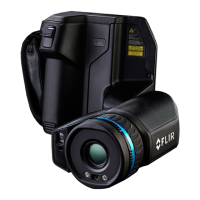Saving and working with images
12
12.1 About image files
12.1.1 General
When you save an image, the camera saves an image file that includes all thermal and vis-
ual information. This means that you can open an image file at a later time and, for exam-
ple, select another image mode, apply color alarms, and add measurement tools.
The image *.jpg file is fully radiometric and saved lossless, which enables full post-proc-
essing in image analysis and reporting software from FLIR Systems. There is also a regu-
lar *.jpg component (lossy) for convenient viewing in non-FLIR Systems software (e.g.,
Microsoft Explorer).
Note
• The camera can also be configured to save an extra low-resolution visual image as a
separate file. This can be convenient if you are not using a post-processing software.
Select
(Settings) > Save options & storage > Photo as separate JPEG = On.
• When the Digital camera image mode is selected, a high-resolution digital image is
stored when an image is saved. However, no thermal information is stored. For more in-
formation, see section 15 Working with image modes, page 64.
12.1.2 File-naming convention
The default naming convention for image files is FLIRxxxx.jpg, where xxxx is a unique
counter.
It is also possible to save images with a date prefix added to the filename. However, these
files may not automatically be detected by third-party applications. For more information,
see the setting File naming format in section 25.1.3 Save options & storage, page 99.
12.1.3 Storage capacity
When you save an image, the camera stores the image file on the memory card.
The size of an image file (with no annotations) is typically less than 1000 kB. Thus, the ca-
pacity of a 8 GB memory card is approximately 8000 images.
Note Empty or use a memory card that has not previously been used in another type of
camera. The cameras may organize files differently on the memory card. There is there-
fore a risk of losing data if the same memory card is used in different types of cameras.
12.1.4 About UltraMax
UltraMax is an image enhancement feature that increases the image resolution and lowers
the noise, making small objects easier to see and measure. An UltraMax image is twice as
wide and high as an ordinary image.
When an UltraMax image is captured by the camera, several ordinary images are saved
within the same file. Capturing all the images can take up to 1 second. To fully utilize Ultra-
Max, the images need to be slightly different, which can be accomplished by a minute
movement of the camera. You should hold the camera firmly in your hands (do not put it
on a tripod), which will make these images vary just a little during the capture. Correct fo-
cus, a high-contrast scene, and a non-moving target are other conditions that help to
achieve a good-quality UltraMax image.
FLIR Tools/Tools+ and FLIR ResearchIR Max have the ability to process UltraMax images.
Other FLIR software will treat the image as a regular image.
#T810253; r. AA/42549/42549; en-US
45

